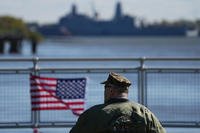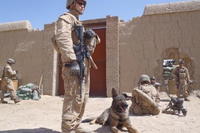Military leaders are considering holding more large-scale exercises in Alaska after the Pentagon canceled several training events on the Korean Peninsula.
About 3,000 Marines and sailors spent this month in Alaska, where they're completing the first iteration of Arctic Expeditionary Capabilities Exercise. They carried out cold-weather amphibious landings, practiced getting fuel ashore in remote locations, and used their underwater robots to hunt for mines in the frigid waters there for the first time.
"One of the reasons we're actually operating here is because ... last year we suspended all exercises on the Korean Peninsula," said Navy Rear Adm. Cedric Pringle, Expeditionary Strike Group 3's commander, told reporters on Monday. "So instead of doing maybe about four exercises per year on the Korean Peninsula, we needed to find another location to do them. This was the perfect environment to do that."
The military this spring canceled the large-scale exercises in South Korea days after President Donald Trump and North Korea's Kim Jong Un failed to reach during a nuclear summit. The decision left critics concerned that the U.S. had caved to the hermit kingdom, since Kim Jong Un frequently complained or lashed out during the exercises.
That appeared to be true even this summer when U.S. and South Korean troops carried out a deeply scaled-back version of one military exercise. The North, in apparent retaliation, fired off a series of ballistic missile tests in apparent retaliation.
Related: US Shouldn't 'Overreact' to North Korean Missile Tests, Defense Secretary Says
Since sailors and Marines couldn't go to the Korean peninsula for exercises such as Foal Eagle or Exercise Ssang Yong, leaders were looking for a place to test logistics operations and keep their troops sharp, Pringle said. That led them to Alaska, where the Marines and sailors on the amphibious dock landing ship Comstock operated in the south-central part of the state and along the far-western Aleutian Islands.
Some portions of the exercise were also held in San Diego. Pringle said the Marines and sailors demonstrated their ability to command and control forces over an area of operation about 2.2 million square miles in size.
The exercises were in many ways similar to those the sea services used to complete in South Korea, he said. But the climate forced them to put their skills and gear to the test in a new environment.
"We need to diversify where we operate and how we operate, because our Navy and our integrated maritime force, it's a global force, and it has to be able to be applied anywhere," he said.
It's likely the Navy and Marine Corps will continue testing putting troops ashore, and then practicing ways to provide logistics in an austere environment, he said.
It's not yet clear how often the services will conduct Arctic Expeditionary Capabilities Exercise in Alaska, Pringle said, or if it will serve as a permanent replacement for any of the canceled South Korean events. The cold-weather exercise could get even colder next time if they push it to later in the year when the temperatures are even more frigid, he said.
"I think we have to challenge ourselves, we have to stretch ourselves," Pringle said. "We have to find the hard venues and prove that we can operate in them."
-- Gina Harkins can be reached at gina.harkins@military.com. Follow her on Twitter @ginaaharkins.
Read More: Marine Corps Finds Unprofessional Command Led to Fatal Midair Crash that Killed 6















